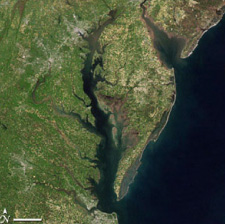The concept of over-fertilization of water has long been understood in freshwater systems, a natural process of
lakes and ponds filling in that's called eutrophication. When Dr. Michael Kemp began doing research in the
Chesapeake Bay in the late 1970s, there was not yet a focus on the over-enrichment of coastal waters. That was
to change, and in a big way. Coastal eutrophication became the biggest organizing concept behind Michael's
research, this integrative theme of how systems respond to nutrient enrichment and how humans have influenced
coastal systems around the world by the inadvertent release of nutrients and other contaminants. Hypoxia – the
state of low oxygen – is what causes what are known as "dead zones", areas in coastal waters in which little to
no marine life is found, and is often caused by eutrophication.
"There's been this expanding understanding of the importance of the
hypoxia problem in coastal waters." |
By the late 1970s Chesapeake Bay had become the ideal place to study these processes, one of the largest
estuaries in in the world, and certainly one of the most studied. One aspect of Chesapeake Bay – known as a
"drowned river" – is its many tributaries. "Each tributary is a microcosm of Chesapeake Bay and we've taken
that tack in a lot of our work," says Michael. "Chesapeake Bay mainstem has hypoxia but many of the
tributaries also have their own version, when oxygen is depleted from the deep water of the estuary primarily
during the summer months." There are also many different kinds of hypoxia. "The kind we're talking about is
primarily where the bottom waters get depleted of oxygen for a portion of every year," says Michael. "This
process is seasonal, and it is generally confined to the bottom waters through a process called stratification,
in which lighter fresher surface waters float seaward over denser saltier waters that flow landward from the
ocean. That's the classic estuarine circulation, and that stratification confines the lower layer so it doesn't
get oxygen replenished."
|
North Atlantic Oscillation |
What is the North Atlantic Oscillation? Visit this website for more information.
|
|
|
Today there is still a large hypoxic zone in Chesapeake Bay, but there are reasons to believe it's on the mend.
One complicating factor is climate. Michael's grad students and colleagues analyzed data on annual change in the
volume of summer hypoxic water in relation to various conditions. These data seemed to indicate that, compared
to past decades, present reduced input of nutrients generates more hypoxia. "Within the last year or two we have
come to realize that climate induced changes like sea level rise and shifts in prevailing wind conditions
that are indexed to the
North Atlantic Oscillation (NAO)
have contributed to increased extent of hypoxic waters, especially in early summer" says Michael. "On the
other hand, both hypoxia extent in late summer and the overall duration of hypoxia are presently declining in
lock-step with decreasing nitrogen inputs to the Bay." He has been able to reassure coastal managers that they
should continue their remediation efforts to reduce nutrient loading in the Chesapeake. "I'm looking forward to
the next decade being a time when hypoxia is going to be much less of a problem in Chesapeake Bay," says
Michael, "both because of the relaxation of climatic conditions but also because of the hard work of reducing
nutrient loading from human societies."
NPR Podcast |
Dr. Kemp explains how shifts in wind patterns have stimulated the appearance of
dead zones in the Chesapeake. Listen to this podcast from National Public Radio: |
|
|
|
Michael's work on hypoxia also provided the framework for his work with COSEE Coastal Trends, in the development
of the
dead zone module. "Ocean
science is a broad topic in which to teach grade school kids STEM, and the problems with dead zones are a
microcosm of that," he says. "This is an applied problem so it tends to grab students' interest. It was a
natural thing for us to use for the module in COSEE Coastal Trends."
Global Applications
Many regions around the world are experiencing hypoxia, and Michael's research is being applied on a global
scale. "It turns out that a few of the well-studied dead zones are in third world developing nations," he says.
"It's good to know that something we've done in the developed world can be of use." The United Nations has an
interest in addressing remediation of hypoxia and eutrophication in developing countries, and Michael serves
on several UN-sponsored committees and the Scientific Committee on Ocean Research (SCOR), focusing on the
magnitude of dead zone formation around the world. "Hypoxia got on the radar screen for this international
initiative," says Michael. "Credit goes to Diaz and Rosenberg to really emphasize the global nature with regional
manifestation."



